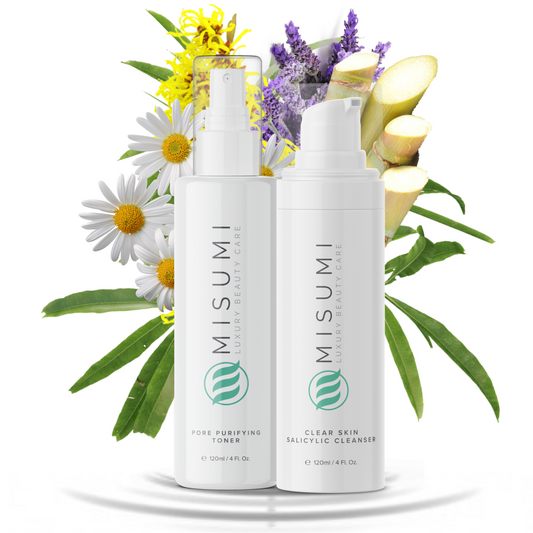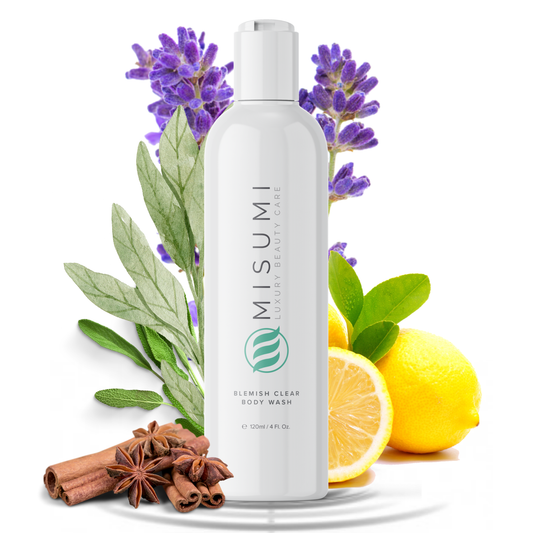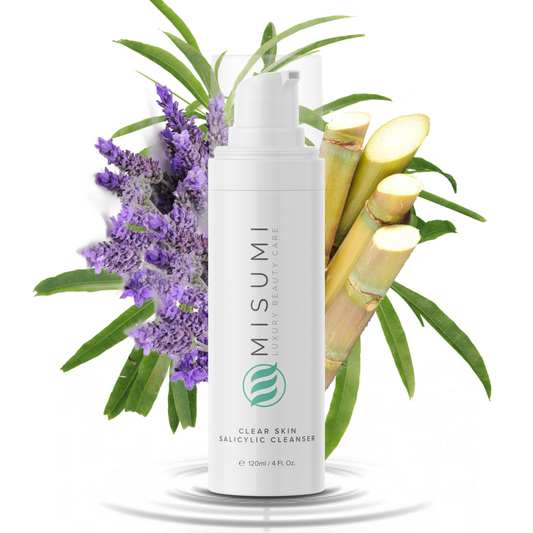Natural acids are becoming increasingly prevalent in various products in the beauty and skincare industry. And for a good reason - as our scientific understanding of nature and our bodies increases, we discover these harmless acids are powerful allies in helping keep our skin healthy.
So far, we’ve covered the amazing benefits of hyaluronic acid for acne, salicylic acid, and L-lysine for acne. We've even compared hyaluronic acid and glycolic acid. Today, let’s look at the benefits of glycolic acid for the skin.
What is Glycolic Acid?
Glycolic acid belongs under the collective acronym of AHAs, otherwise known as alpha hydroxy acids. AHAs are mostly found in various kinds of fruit, with their main industrial source being sugar cane. And although AHAs, including glycolic acid, can be derived from many fruits, those derived from sugar cane are considered some of the safest for human use. While the specific reasons for this are not well known, it can be speculated that humans are better adapted to sugar cane than to exotic fruits.

It also may be because glycolic acid derived from sugar cane is the most similar to the one our bodies naturally produce. That’s right - as a product of our metabolic processes, glycolic acid is naturally produced in the human body in small amounts. Scientists call this human-made glycolic acid hydroxyacetic acid. However, the amounts our bodies produce are far from enough.
But what does glycolic acid do? Let’s find out.
What Does Glycolic Acid Do?
Glycolic acid is sometimes referred to as the “Queen of Exfoliants.” There are good reasons for this, but it’s mostly due to what glycolic acid does. Glycolic acid works by dissolving dead skin cells found on the skin's surface by breaking the bonds that hold them together. Glycolic acid aids the skin's natural regeneration cycle, helping our body renew itself.
But not only that - this chemical exfoliant performs many other important roles in maintaining skin health. For example, glycolic acid stimulates the production of collagen and elastin, which are the building blocks of many tissues in the body, including the skin. Elastin makes our skin flexible and elastic, while collagen is the glue that keeps our skin cells together.
Additionally, glycolic acid promotes the creation of brand-new skin cells, speeding up our skin's rejuvenation process and slowing skin aging. This makes glycolic acid a key friend in achieving young-looking, clear skin and maintaining a flawless, glowing complexion.

As if that wasn’t enough, topical glycolic acid has many anti-aging properties, making it suitable for people who want to eliminate lines, wrinkles, blemishes, and other kinds of discoloration.
The combined exfoliating and rejuvenating properties of glycolic acid make it a popular candidate for exfoliating products and chemical peels. It can also be found in many anti-acne creams, moisturizers, and skincare gels aimed at healing scars and acne scars.
Glycolic acid is simply too useful to be reduced to one type of application.
What is Glycolic Acid Used For?
Glycolic acid can be used for various purposes and in various ways, from chemical peels to creams.
However, some uses are better than others. For example, you wouldn’t want to use glycolic acid as a spot treatment because the benefits would be negligible.

Here are some of the best and most useful applications of glycolic acid products.
Glycolic Acid Can Be Used in Treating Acne
By now, you’re probably aware of how acne comes to be. The cocktail of dead skin cells, excess skin oil (sebum), acne-causing bacteria, and random dirt all clog your pores. And if you don’t take action, they’ll turn into acne.
Acne prevention can be done by disrupting or disabling elements in the acne-forming chain we just described. And glycolic acid is an expert in breaking one of them: dead skin cells.
Glycolic acid breaks up the bonds holding skin cells together. While this may give you some pause, you shouldn’t worry. Glycolic acid is too weak to dissolve your normal skin; it can’t even penetrate that deeply. However, these bonds are much weaker when it comes to aging, or dead skin cells, which become stuck on the surface of your skin. This is where glycolic acid comes in as super handy.

Introducing a glycolic acid cleanser in your skincare routine can help you prevent acne. Mopping up your skin of dead skin cells helps keep your pores clean and clear instead of clogged and infected. Therefore, glycolic acid can be very helpful for acne-prone skin. Additionally, since this acid also promotes the production of collagen, elastin, and new skin cells, it can be used as a regenerating treatment and applied after your active breakouts have healed.
Glycolic Acid is a Safe and Powerful Exfoliant
As mentioned briefly above, glycolic acid is often considered one of the best exfoliants for dry skin. Its specific molecular structure allows it to dissolve the so-called “glue” that keeps skin cells attached to one another. Since this effect is only powerful enough to affect the surface layer of the skin, glycolic acid is harmless to normal skin. It only sloughs off the dead and dying skin cells at the top layer of our skin.
Now, the top layer of our skin is directly exposed to the elements. It has to deal with intense heat waves during summer and extreme colds during winter while suffering the corrosive effects of free radicals produced by pollution.
Last but not least, the surface layer of the skin is constantly bombarded with the sun’s harmful UV rays. All of this makes the surface layer more damaged, filled with rugged, dying cells or hardened skin cells that have accumulated dust and dirt. That microscopic layer of damaged skin cells makes our skin look darker than it is, acting like a sort of patina over our skin.

That's where glycolic acid enters the picture. It provides a painless, effortless method for exfoliation since it doesn’t require rubbing or microbeads. Glycolic acid simply dissolves most of the skin's damaged, darkened surface layer through a chemical reaction. Once all that dirt, dust, and gunk gets removed from your body, a healthy, clean layer of skin becomes visible. Even the age lines, spots, and wrinkles become less pronounced since one of their layers has been chipped away. Suddenly, your face looks a lot brighter, smoother, and in one word - younger.
What makes glycolic acid such a popular exfoliator is its relatively safe and effortless action. In comparison to other exfoliants, glycolic acid doesn’t require much physical activity to work its magic. It simply unglues the connections between healthy skin and all the dead and damaged skin cells. In contrast, other scrubs and exfoliants will contain microbeads and need you to rub those beads over the desired area. Trust us; you don't want to over-exfoliate your skin.

Additionally, glycolic acid peels or exfoliants have a more uniform effect over a broader area. You simply apply the glycolic acid product, and when it’s done, the entire area is evenly cleaned and rejuvenated. But that is not so with the other classical exfoliants. A product that contains microbeads and requires rubbing will not work its magic on all areas equally. You’ll quickly lose patience, rubbing more intensely over one area and neglecting another, and sooner or later, you’ll feel that familiar burning sensation. You wanted to clean your face, not make it all sore and red.
None of that happens with glycolic acid.
Glycolic Acid Combats Signs of Aging
As we age, our bodies become less and less efficient in supplying themselves with many important ingredients. Among these are several AHA acids, most notably hyaluronic acid and glycolic acid. The already tiny amount of glycolic acid the body produces becomes tinier, contributing to the overall aged look.

However, there is no room for despair. Thanks to modern science, we can still harness the benefits of glycolic acid to combat aging. There is a vast selection of products that contain glycolic acid, so it’s entirely up to you which one you choose. As we mentioned before, glycolic acid has several beneficial skincare properties.
As a moisturizer, glycolic acid protects your skin from drying out, helping you retain moisture. Additionally, its collagen and elastin-producing properties smoothen out fine lines and wrinkles and help the skin regenerate itself. This combined makes glycolic acid one of the most powerful skincare ingredients in achieving a smooth, youthful look.
How Safe is Glycolic Acid?
We’ve mentioned that glycolic acid, and most of the AHA acids, are fairly safe. Just because they’re technically referred to as acids don’t mean they’ll burn your skin or hurt you in any way. After all, our bodies produce glycolic acid, so why would there be any concerns?

Well, the human body is complex, and there are still people who can react adversely to glycolic acid. Although our bodies produce it, using this alpha hydroxy acid topically can produce an allergic reaction. While these allergic reactions happen in one person out of a million, it’s still wise to do a patch test before using a glycolic acid product, whether glycolic acid peel products, glycolic acid toners, or cleansers. In case you have skin irritation, stop using the product immediately and talk to your doctor and dermatologist.
Those with sensitive skin should be especially careful.
Additionally, glycolic acid can make your skin more sensitive to photoaging, leaving you scratching your head as to what just happened. To counter this, it's recommended that you always use sunscreen whenever you apply glycolic acid. The sunscreen will counter the acid’s sensitivity to sunlight while keeping its beneficial properties untouched. Name a better duo, right?

Pregnant women should not take glycolic acid in the form of oral supplements.
Additionally, people trying to treat acne can sometimes take Accutane (also known as Roaccutane). However, Accutane can also make your skin sensitive to sunlight, and glycolic acid, while harmless, can exacerbate those effects. For this purpose, it’s always wise to consult your doctor or dermatologist about whether you should use glycolic acid while taking Accutane.
Conclusion
Glycolic acid is a completely natural ingredient that works wonders for our skin. It dissolves the bonds that hold our dead skin cells together, cleaning our skin painlessly and effortlessly. That is why it's used in many exfoliating products and procedures.

Additionally, glycolic acid can stimulate collagen production, two key ingredients in charge of human skin elasticity and flexibility. That makes glycolic acid suitable for treating acne and helping the body repair itself faster and reduce the formation of scars.
This alpha hydroxy acid is an effective anti-aging substance. By removing the worn-out surface layer of the skin and producing collagen and elastin, glycolic acid removes old skin and creates new skin - simultaneously.
All of the above makes glycolic acid one of the best and safest alpha hydroxy acids for your skin, its health, and your well-being. Give it a try, and you won’t regret it.
Conclusion
Dual Effects of Alpha-Hydroxy Acids on the Skin









